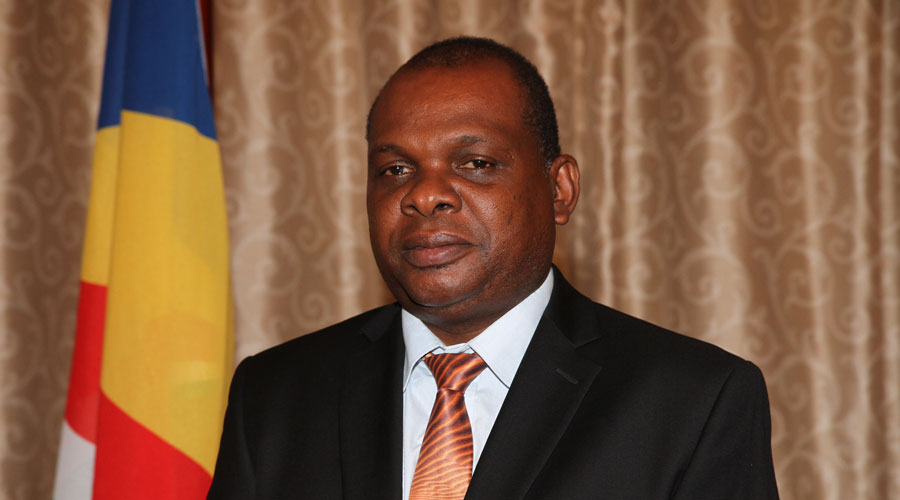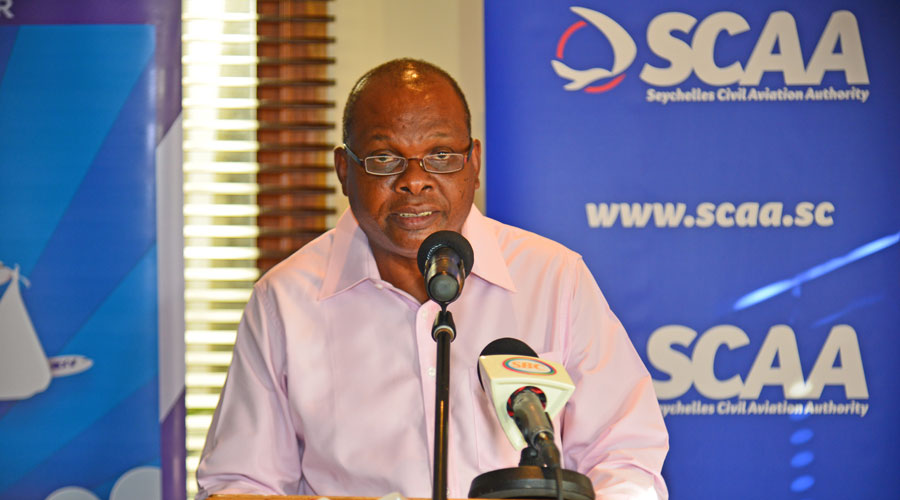
As Seychelles’ environment minister until recently, Didier Dogley is determined to bring a green perspective to his stewardship of the tourism industry. The new minister of tourism, civil aviation, ports and marine outlines his strategic plan to boost the tourism and improve infrastructure while maintaining sustainability – the key attraction of Seychelles, and, ultimately, its lifeline
You have just been named minister of tourism, civil aviation, ports and marine, after previously serving as minister of environment, energy and climate change. Where do the two portfolios overlap, and how is your depth of experience informing your overall vision for your new post?
I have worked most of my life in connection with the environment; it is my life and passion. Living in a beautiful environment like the Seychelles, it’s easy to understand why anyone would care so much about this issue. Tourism and fishing are the two main pillars of the economy, and both depend on the quality and health of the environment. Tourism in Seychelles is nature-based with a wide range of recreational activities such as swimming, snorkelling, fishing, sailing and diving taking place within the coastal environment. Under the waves the marine life is a major attraction; visitors can experience up-close the diversity of life on coral reefs and the other marine ecosystems. On land there are a number of well managed trails within and outside the protected areas, where people can discover the beautiful landscape and flora and fauna that we have. Most tourists come because of our pristine and unique environment. Having a good understanding of these linkages is critical for any tourism minister to be able to manage tourism in Seychelles successfully.
As minister of environment, energy and climate change, you and the nation pioneered several programmes related to the Blue Economy and environmental sustainability that caught the world’s attention. How do you hope to make Seychelles more pioneering in the realm of tourism?
Working as minister of environment allowed me to come up with new and innovative ideas to better steward the environment. Many ideas from other, larger countries do not work here so we need to come up with our own and test them before we can adopt them as part of our national development program. We have been quite successful in that way. Tourism has been developing here since the 1960s, and the fundamental thing that has made it work for Seychelles is that we have always chosen sustainability, taking into account the size of an island, its population and going for quality. When we sell ourselves as a tourist destination, it is always as a group of islands which are unique, but also very fragile. We try to keep the numbers in check by going for high-end tourism. Now, my job is to work with the industry to create a model that can be an example to the world in which the quality – not only of the islands themselves but also the facilities, restaurants and so on – will set new standards by focusing on our unique hospitality. Sixty percent of the hotel beds on offer are in small, family-run hotels. For me, that is where you discover the true creole flavour – you can hear the beautiful sounds of local people speaking creole, indulge yourselves in the local cuisine and get a better understanding of the culture. We need to do more in offering our uniqueness to visitors who come here from Europe, Asia and all over the world. We have been here on these islands for centuries and our population is a true mixture of all ethnic groups, so using our cultural blend is also an act of conservation.
In 2011, when the Seychelles Tourism Board established its first office in China, visitor arrivals from the country stood at only around 200-2,000 annually. But last year that number had risen to 11,710. What is your view on the importance of the Chinese tourist market to Seychelles, and your strategy to attract more visitors from the world’s most populous country going into the future?
We need to diversify our market to be less reliant on Europe – there’s no question about that. But I don’t think we have fully grasped what the Chinese tourist is looking for yet. There is a lot of work for us to do here to make sure that what we offer meets the needs of the Chinese. We need to study what attractions will work for them; golf is always interesting, for example. Recently, we have witness a shift towards the younger and more effluent Chinese visitors. This is for us an interesting development. It is also important to look at the connectivity. Before, Air Seychelles was running a direct flight to Beijing, but this has been dropped. We have connecting flights arriving every day, but if we want to substantially increase the quantity of Chinese visitors, returning to direct flights is a big part of the answer.
As well as building tourism, how do you see hope to collaborate on a government level with China in the future?
Seychelles and China enjoy excellent bilateral relationship, since 1976, the year in which we became independent. China has helped us a lot in terms of development, building schools and even building our parliament and judiciary buildings. It is the country that offers the highest number of scholarships for our students and more and more we have professionals who also speak Chinese. They’ve been an excellent development partner. China has a fully-fledged embassy in Seychelles and we have an embassy in China, so all the ingredients are in place to develop cooperation. The relationship can only go from strength to strength.
What kind of strategy are you looking to put in place to boost Seychellois tourism, while maintaining the values of the brand?
We sell the environment as our main attraction. People come here because we offer very clean air, wonderful land and seascapes, world-class attractions and crystalline waters. We have around 6,000 beds at the moment, and the moratorium on large hotels is in place until 2020, when we will reassess. People don’t want to come here and find it crowded, and we also have 17,000 foreign workers here as well, which is another factor. So, yes, we need to grow the economy, but we have to think strategically. We have 115 islands, and we are looking at some of the outer islands as places to follow the one hotel per island policy, so that we do not have to keep filling the main islands with hotels, but expand elsewhere. So far, we have done well in that we have the tourism that we want to have, attracting high-end individuals, and we have excellent hotels catering for them. But we also have visitors at small guesthouses where they typically pay around $90 a night. We don’t target backpackers, but we do want Seychelles to be affordable, as well as a place for high-net-worth individuals. But we have to study, consult before deciding exactly where we want to go in terms of numbers. Our ultimate aim to offer each and every visitor to our shores a distinct and unique creole experience that they will not find anywhere else. This is why managing the numbers is so critical for us.

What activities or regions in Seychelles would you recommend to visitors, especially with the Chinese market in mind?
We have a number of casinos and special excursions that can be arranged. There is island-hopping, where you can take a boat or a plane and experience various islands and the different scenery they have to offer. A lot of people only go to Mahé, Praslin and La Digue, but there is also a day trip to Silhouette and other islands you can do on a boat. Then there is the incredible Vallée de Mai reserve and trails for those who like to walk and discover animals and plants and the exceptional scenery. But apart from the conventional attractions we want to promote other activities, such as cooking, dancing, yoga, rock-climbing, zip lining and others. I feel we need to diversify the number of activities on offer, so I am having a report drawn up on what other things are provided in other parts of the world to see which ones are compatible with Seychelles. Of course, they must be ethical, sustainable and safe for the people participating. This will also help the economy, as people would be doing more things during their day, providing work and income to the locals.
Besides tourism, your portfolio also includes civil aviation, ports and marine. As China ramps up its Belt and Road Initiative, what are your thoughts on the opportunities for Chinese companies to boost infrastructure in Seychelles?
In the port sector and fisheries, there are a number of initiatives where we can bring in foreign direct investment (FDI), such as fish processing. We need to look at our infrastructure and see where investment is most needed before we put projects out for tender. I am still relatively new in the ministry, but I definitely believe we need investment from outside to improve our gateways. The airport is an example; it’s quite old and it’s clear that in the next five years it will not be able to cope. We will have to probably build a completely new airport.
Finally, how would you describe the Seychelles to someone who has never been here? What makes this one of the most special places on earth?
Seychelles is unique from its very origins; they are the only remote oceanic islands made of granite on Earth. These islands are the same age as Africa – 600 million years old. We are looking at the mountaintops of a mini-continent that is on average 60 metres beneath the sea. Our plants and animals are absolutely unique. People talk about the giant tortoises of Galapagos, but we have more of these docile giants that people here in Seychelles. There is also the incredible mixture of people from all over the world that came here and became a nation, developing our own unique creole culture. Because of these roots, we are very welcoming, as well as being well educated; many Seychellois speak three languages –English, French and Creole – or even more. It’s a melting pot. And it’s also a very safe destination, with very few major crimes having been committed. Seychelles is politically stable and has a multiparty democracy. The economy is doing well and the facilities and infrastructure are there. Our air has been rated as the cleanest in the world, as has our water, and planning rules are very strict so that we do not damage the image that we sell – and love. As soon as you fly in and get that first view, you realise you are in paradise – even if it is only for 10 days.